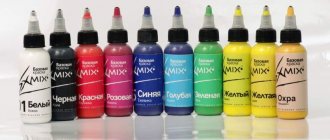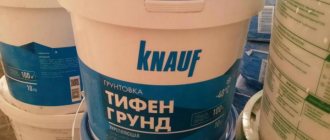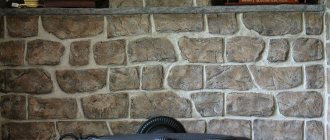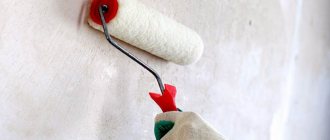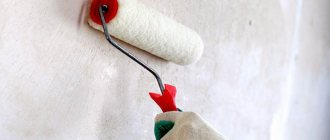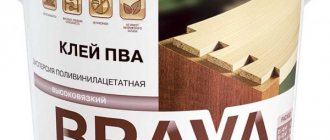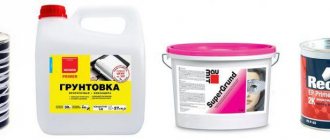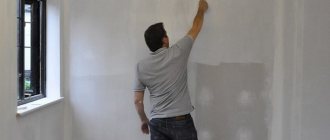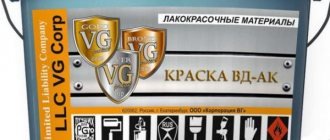Professional experts advise that you must prime the surface of walls and ceilings before painting or wallpapering them. People who are far from the sphere of repair and finishing work may think that priming is not such an important procedure. However, experienced finishers say that priming the surface is a very important step during repairs; this procedure cannot be neglected. There are several types of primer compositions, one of the widely used ones is oil primer. The main properties, purpose and types of this soil will be discussed in this article.
Purpose
To ensure that the finishing material adheres firmly to the walls and ceiling, when performing interior repair work, the base must be covered with a primer mixture before painting or wallpapering. Thanks to priming, the finish will be durable, will not crack or fall off, and the wallpaper will not peel off or peel off.
The high technical characteristics of the primer allow it to significantly increase the adhesion rate of plaster, putty and finishing materials, so the walls and ceiling will remain attractive for a long time, remaining the same as they were immediately after the repair. There are many primer compositions on the market and in stores, and it is very easy for the average person to get confused, because it may not be clear which type is best to choose.
Oil primer - types, technical characteristics and application
Check Also
Question: “What is the difference between paint and enamel?” - sounds very often, but even those who are associated with paint and varnish materials by profession cannot always give a clear answer. There is a widespread belief that enamel is...
PF primer: types of pentaphthalic compositions, features of PF 010M, PF 020 and PF 031, application Today, the building materials market offers many different primer compositions that have different properties and are intended for different purposes. Among …
Wallpapering walls is one of the most popular types of finishing work. There is a huge selection of wallpaper on the market: from traditional paper “trellises” to glass wallpaper. There are also so-called “liquid” wallpapers, which are applied to the wall according to...
Technical characteristics of acrylic facade paint for exterior work The final phase of the exterior decoration of the house is covering the walls with a finishing layer of facade paint. This procedure finally creates the intended appearance of the building, hides some defects or masks different colors...
PVA-based primer - how to make it yourself PVA primer is a solution for preliminary preparation of surfaces for finishing, which is prepared independently: from a mixture of glue and water. Homemade mixture is popular among home craftsmen...
Facade paint for plaster: types of compositions, preparation and application Plaster is an integral part of any facade, and in construction it also remains a finishing touch. However, for all its functional qualities, it looks rather unsightly in appearance, remaining...
Primer Otex (Tikkurila) - Otex (Tikkurila). Review. Properties, characteristics of the primer. Application and use experience. Using Otex primer from Tikkurila. Review, features of use, properties. (10+) Otex primer (Tikkurila) Review Otex goes on almost any surface: wood, ...
In the modern world, there are a large number of materials that are used to protect against corrosion. They cover the metal surface with a thin layer of film, which prevents iron and other types of metals from oxidizing. Many types of anti-corrosion substances...
Primer before floor screed: groups of primer mixtures and types of screeds Primer compositions are used in construction for certain tasks, depending on the type of base. Below we will look at what they are, why they are used and for what screeds...
Primer GF-0119 is a mixture based on pentaphthalic (or glyphthalic) varnish, which contains protective fillers and pigments, stabilizers, and a drying agent with the addition of an organic solvent. The surface of wood or metal must be primed before applying a layer of enamel. GF-0119…
Primer EP-057 - technical characteristics, scope and methods of application For tread protection of products and various structures made of ferrous metals from corrosive effects and before subsequent painting, special primers based on epoxy and polyamide are used ...
Deep penetration primer: composition, purposes of application, application technology 1 What is it 1.1 Functions 1.2 Composition 1.3 Basic characteristics 1.4 Operating principle 2 Application 2.1 Technology 3 Study of samples 3.1 Mixonit GR43 3.2 Acrylic primer 4 ...
High-quality preparation of the base brings adhesion to maximum values, improves the insulating characteristics of materials, facilitates finishing work and significantly reduces the time required to complete it. Bitumen primer allows you to save about 1.5% of the total cost of the estimate, reduce costs for ...
Features of facade paint for wooden surfaces When building houses, among all existing materials, wood is in great demand. This is due to its environmental friendliness, high wear resistance and the ability to retain heat well. In order to preserve all the positive properties...
What is the best paint to paint the outside of a wooden house? It’s not enough to just build a beautiful wooden house. In order for it to serve for many years without losing its original appearance, the facade must be properly processed. You can, of course, order material that professionals will process with special means...
Primer before wallpapering. Plastering, puttying and priming. Choice of primer composition. Technology When starting a cosmetic renovation in their home, not everyone understands what they will have to face, remembering how their parents dealt with...
Oily soils
What is an oil primer? This is an alkyd mixture based on synthetic oil resins; it also contains grated paint and drying oil, thanks to these components you can choose the color of the primer. If the composition is supplied in the form of a spray or aerosol, the can must contain a solvent. And if the solution is in a metal can, then the composition will not contain solvents; it must be applied either with a roller or a brush.
To protect yourself from purchasing counterfeit, low-quality goods, you must purchase a solution that has a quality certificate. Such a mixture will have the best characteristics; an oil primer certificate is a document confirming that the product complies with GOST and the requirements of other regulatory documents.
General information
Purpose
In order for the finishing material to adhere firmly to the surface of the ceiling and walls, when performing interior repair work, the base must be coated with a primer mixture before painting or wallpapering. Due to priming, the finish will be durable, will not crack or fall off, and the wallpaper will not peel off or peel off. The high technical characteristics of the primer composition enable it to greatly increase the adhesion index of plaster, putty mixture with finishing materials for finishing, and therefore the ceiling and walls will retain an attractive appearance for a long time and will remain the same as after repair. There are many primer compositions in construction stores and on the market, and usually it is very easy for a person to get confused, because it may not be clear which type is best to choose.
Oil based primers
What are oil primers? This is an alkyd-type mixture, which is based on synthetic oil resins, and also contains drying oil and grated paint, due to which the color of the primer composition can be selected for such components. If the composition is supplied in the form of an aerosol or spray, the can must contain a solvent. But if the solution is in a metal can, then the composition will not contain various solvents; it should be applied either with a brush or a roller. To protect yourself from purchasing counterfeit or low-quality goods, you should buy a solution that has a quality certificate. Such a mixture will have the best technical characteristics, and the oil primer certificate is a document confirming that the product will comply with GOST and the requirements of other regulatory documents.
Main technical characteristics
Below are all the technical characteristics of the oil primer. Typically, these types of wall treatments have a matte color, due to which they are considered universal, and because they can be tinted. As a rule, oil-based primers have a consumption of 0.05 to 0.1 kg per square meter, and this parameter will depend on what type of surface the mixture will be applied to and what absorbent characteristics the base has. The thickness of one layer of oil primer is less than 0.1 cm.
Under standard conditions of use, the primer layer will dry completely after approximately 1 day. After this time, you can begin to apply the next layer. Before applying a layer of oil primer, the manufacturer advises to thoroughly mix the mixture.
The main advantages of the product
The excellent properties of the oil-type primer composition give it the following advantages:
- Serves as a reliable protection for the base, which is subsequently painted with any type of oil paint.
- Structures or products made of wood acquire a high level of resistance to moisture.
- It is a natural antiseptic for various surfaces.
- Due to the fact that the mixture can be tinted, it is very easy to decorate the primed base. In addition, the texture and shade of the primer will not be visible through the layer of paintwork material.
Main characteristics
Below are the technical characteristics of the oil primer.
Typically, these types of primers have a matte color, due to which they are considered universal because they can be tinted. Typically, an oil-based primer has a consumption of 50 to 100 grams per square meter, this parameter depends on what surface the mixture is applied to and what absorbent properties the base has.
The thickness of one layer of oil primer is less than 1 millimeter. Under normal conditions of use, the primer coat is completely dry in approximately 24 hours. After this time, you can begin applying the next layer. Before applying a layer of oil primer, the manufacturer recommends stirring the mixture thoroughly.
Advantages and disadvantages
Advantages of oil primers
These compositions have a number of quite significant advantages:
- Firstly, they are almost ideal for preparing surfaces for treatment with oil and some other paints.
- Secondly, penetrating into the thickness of the wood, the active substances provide its protection from moisture and also act as a natural antiseptic.
- Thirdly, the possibility of tinting this primer makes it much easier to decorate the product with paint. Difficulties associated with the appearance of texture or color of the base practically do not arise.
Hydrophobic properties help preserve the wood base
Key Disadvantages
If we talk about the shortcomings, they are as follows:
- The main disadvantage is, of course, low versatility. Oil-based primers can only be used under oil or acrylate paint, and it makes sense to apply them only on wood or metal. In all other cases, treatment with this primer will only worsen the level of adhesion.
- Another disadvantage is the difficulty of applying over large areas. Thick soil cannot be sprayed with a spray gun for painting, so you will inevitably have to take up a brush and spend considerable time doing preparatory work.
The material cannot be sprayed, so we are forced to work as shown in the photo - with a brush!
- The applied material takes a long time to dry, which can lead to downtime during repairs. At the same time, the oil base is very sensitive to atmospheric humidity, therefore, without creating the necessary conditions, you may not wait for complete drying even after several days.
And yet, in some cases, it is almost impossible to find a full-fledged alternative to this tool, so you will have to put up with the shortcomings.
Main advantages
The excellent characteristics of the oil primer give it the following advantages:
- serves as a reliable protection for the base, which is subsequently painted with any oil paint;
- products or structures made of wood acquire a high level of resistance to moisture;
- is a natural antiseptic for surfaces;
- Since the mixture can be tinted, it is very easy to decorate the primed base. In addition, the shade and texture of the primer will not be visible through the paint layer.
Composition of primer VAK 01 U
The VAK-01-u primer has a high-grade universal concentrate, which allows it to be used as a strengthening liquid in interior finishing work. It consists of the following components.
- Resins, drying oils. The oil base is responsible for the viscosity of the mixture.
- Latex or rubber water dispersion.
- The hardener, which helps accelerate the drying of the soil, is a drying catalyst.
- The smallest auxiliary components are lime particles, chalk and marble chips.
- Components responsible for increasing the strength of the treated surface.
- Vinyl-acrylic modified composition elements.
Types of oil-based primers
There are 2 types of acrylic and oil primers sold in stores:
- universal primers have the best technical characteristics, thanks to which these mixtures can be used for treating concrete and brick bases, but they cannot be used for priming any metals and wood. Universal primers are great for protecting walls and ceilings before wallpapering or painting;
- Primer-paints are used to coat wood and metals. In addition to effectively protecting the surface and enhancing adhesion, these oil-based primers also have antifungal properties. Usually available in white, so the primed surface looks like it has been painted.
Phenolic primer
It is classified as anti-corrosion. Designed for processing wood and metal surfaces, in particular titanium, copper and ferrous metal bases. In addition to its anti-corrosion properties, phenolic primer can increase the service life of the treated base and its subsequent finishing.
Compound:
- varnish based on synthetic phenol-formaldehyde resins;
- vegetable oils;
- solvent.
As you can see, the soil is not environmentally friendly, so it is better to avoid using it for treating indoor surfaces.
The surface is ready for finishing after 12 hours.
Oil primer vac iv
To treat concrete, cement and other mineral bases, an oil-vac primer is used before painting or before adhesive coating. This mixture reduces the absorbent properties of the base, thereby reducing the consumption of paints and varnishes. In addition, vac iv improves the quality of the finishing coating and extends its service life. This soil dries quickly enough and has almost no odor.
Typically, an oil-vac primer has a consumption of 70 to 100 grams per square meter for single-layer application. At a temperature of 20 degrees and humidity not higher than 65%, it dries in 1 hour. Vak IV primer must be applied at a temperature of at least 8 degrees. Before applying, be sure to stir the mixture; the surface can be treated using a roller, brush or spray.
Vak IV contains no toxic or harmful substances to humans; water is used as a diluent, not a solvent, so this oil type of primer is fireproof. Vac IV should be stored in a hermetically sealed original container, in a temperature range of 5-30 degrees, for no longer than 12 months. If Vak IV primer gets on your skin or eyes during application, you should immediately rinse them with a large volume of running water.
Analysis of market offers
What are heat-resistant soils? Let's take a look at several offers on the modern market as examples.
Alkyd heat-resistant primer is produced according to TU-2312-030-00206919-2002 and is a suspension of pigments, antioxidants and surfactants in glyphthalic varnish.
What can you tell about its properties and features?
- The primer is intended for steel, magnesium and aluminum surfaces. In particular, GF-031 is used in civil aviation - for applying coatings to aircraft bodies.
- The maximum operating temperature is +200C.
It’s interesting: the reservation about civil aircraft construction is not accidental. The outer skin of an interceptor fighter at a speed of about 2.5M (2.5 times faster than the speed of sound) due to friction with the air heats up to 300-500 degrees.
- Solvent - solvent; It is also used to dilute the soil when it thickens.
- Application method: spray or using a hand-held painting tool.
- The thickness of the single-layer coating after drying should be 15-20 microns. Primer consumption per layer is 60-80 g/m2.
- TU specifies the color of the pigments used. Produced according to technical specifications GF-031 - yellow.
Phosphosoil
The name is a trademark of the Moscow company KrasKo. As you might guess, we have the so-called phosphating primer.
It reacts with the base and forms a thin layer of insoluble phosphates that improve adhesion and prevent corrosion.
Chemical composition of the phosphating reagent.
- A mixture of acrylic, formaldehyde and epoxy resins is used as a binder. It is logical to assume that the primer is intended exclusively for open air or industrial conditions: formaldehyde in a residential area will clearly be unnecessary.
- Operating temperature range - up to +300 degrees.
- Thanks to its composition, the primer can be used with any type of heat-resistant and conventional paints. It can be used not only on metal: the manufacturer allows it to be used to improve the adhesion of the final coating on fiberglass or ceramics.
- The primer can be applied not only to a previously cleaned surface, but also to a rusty surface.
However: when applying a primer with your own hands, it is still worth first removing sheet and loose rust. The phosphating composition can change its chemical properties, but it will not change the spatial structure of the fragile oxide.
- Phosphosoil is diluted with acetone or toluene.
- Thanks to organic solvents, the composition can be applied at low temperatures down to -10C. Drying time for a single-layer coating at +20 is no more than 30 minutes.
- The average primer consumption is 70-90 grams per square meter.
The photo shows the packaging of Phosphogrunt.
This heat-resistant primer for stoves and fireplaces impresses with its heat resistance. Its stated operating temperature is 1200 degrees, which, you see, is very impressive compared to the previously described solutions. The composition of the water-dispersed primer is not disclosed by dealers; however, the colossal heat resistance suggests that the main binder in G-77 is heat-resistant silicone.
Applying primer has two purposes:
- Improving the adhesion of putties and plasters.
Useful: at high operating temperatures, you can forget about the usual gypsum and cement mixtures. A mixture of clay and sand is used to decorate stoves and fireplaces; Often, skim milk is added as a binder: the casein contained in it (milk protein, also known as low-fat cottage cheese) retains excellent binding properties even with temperature denaturation.
Plastering the stove with clay mortar.
- Strengthening the foundation. The resins contained in the soil penetrate its pores and bind the surface layer of the material into a single whole.
What other information about primer is available to a potential buyer?
- Application is quite traditional - with a roller or brush in two layers.
- Drying time for one layer is no more than an hour. At least two hours must pass before further finishing begins on the primed surface.
- Priming is performed at positive temperatures. Water based, remember?
- Consumption is no more than 400 milliliters of soil per square meter of surface.
Heat-resistant penetrating G-77 is supplied in plastic canisters of 1 kilogram.
Priming rules
The primer must match the composition of the paint that will be applied over the primer. The store purchases a suitable type of primer, as well as the following tools:
- a cuvette container with a ribbed area for spinning. This container will be used to pour the primer mixture;
- brush and roller for surface treatment;
- If you don’t have a stepladder, you need to buy a telescopic handle.
Before you start priming walls, ceilings, or any other structures and products, you need to remove dirt, dust, remnants of old finishing materials, greasy stains, and other contaminants from them. If metal is to be primed, it must be cleaned of rust.
The finished primer is poured into a ditch, a roller or brush is lowered into the mixture, passed over the ribbed surface several times to remove excess composition, after which the mixture is applied to the surface. It is advisable to apply two coats of primer, but make sure that the first coat of primer is completely dry before applying the second coat. Drying time depends on the temperature and humidity in the room. Even a beginner can handle priming; there is nothing difficult about it.
Alkyd primer
This is a primer based on alkyd resin. Area of application: primary treatment or application to previously painted surfaces made of wood, particle boards, and wood fiber. It also has excellent adhesion to PVC, glass, galvanized steel, fiberglass, and tiles. White spirit is used as a thinner and cleaner.
Any type of paint fits perfectly on it: latex, alkyd, enamels, acrylic, nitro dyes, all types of putties, PVA glue, universal and wallpaper glue.
The composition of the alkyd primer allows you to work with it even at low temperatures; its toxicity is relatively low, which does not require special protective measures, except for constant ventilation of the room during work. Among the advantages of this soil are its availability and low price.
In turn, the material comes in three types:
- A special moisture-proofing primer has anti-mold and antifungal properties
- Pigmented primer creates a semi-matte, durable film and enhances the depth of the next color
- Zinc in the mixture gives it anti-corrosion properties.


